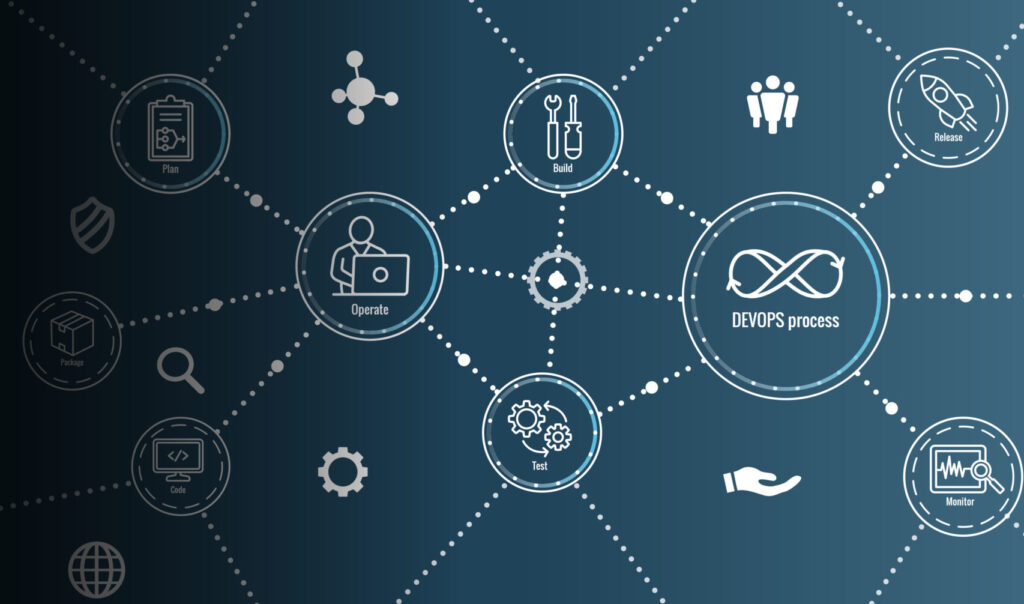
DevOps-as-a-Service (DaaS) provides a practical approach to adopting DevOps by offering managed tools, infrastructure, and expert support. However, choosing the right DaaS model – whether fully managed or toolchain-only – requires a clear understanding of how each option affects scalability, required expertise, and control over DevOps decisions.
Scope and key concepts
DevOps integrates development and IT operations to improve collaboration and speed up software delivery.
DaaS – available in different configurations (fully managed, partially managed, and toolchain-only) – enables businesses to adopt DevOps with greater flexibility, scalability, and standardized practices.
When selecting a DaaS model, business owners should assess their scalability requirements, internal DevOps expertise, and the level of control they need.
What is DevOps and DaaS
DevOps is a methodology that merges software development (Dev) with IT operations (Ops) through a set of practices, tools, and mindset shifts. Its goal is to accelerate time to market, shorten the software development lifecycle, and consistently deliver high-quality software. By eliminating the traditional barriers between development and operations, DevOps fosters shared responsibility for the product and promotes a collaborative culture.
DevOps as a Service (DaaS) is a service model that provides organizations with the tools, practices, and infrastructure necessary to implement and manage DevOps processes, eliminating the complexity of manual setup and management. With DaaS, companies can focus on their core competencies while outsourcing the implementation and management of DevOps to a third-party provider.

Challenges in adopting DevOps and how DaaS helps
Adopting DevOps is a transformative process, but it comes with its share of challenges. DevOps-as-a-Service (DaaS) offers a simplified approach to overcoming these obstacles by providing expert support, standardized practices, and scalable solutions tailored to each organization’s needs.
Let’s explore how DaaS addresses some of the most common challenges in DevOps adoption.
One of the biggest hurdles is cultural resistance to change. Shifting to a DevOps culture requires moving from siloed work to collaborative efforts, which can face significant pushback. Teams that are used to traditional roles may feel uncomfortable with a more integrated, cross-functional approach.
DaaS providers help by offering experienced trainers and guiding teams through the process of adopting a DevOps mindset. By introducing new practices gradually, DaaS minimizes resistance and builds confidence in the benefits of the transformation.
On the technical side, streamlining toolchain integration is another challenge. Choosing the right tools for CI/CD, continuous testing, and monitoring can be difficult, especially when dealing with legacy systems.
DaaS providers offer pre-configured toolchains that simplify integration and reduce compatibility issues. This approach relieves teams from the burden of configuring and maintaining an integrated toolchain, allowing them to focus on delivering value to customers.
Another common challenge is measuring and guiding progress. For companies already making strides in their DevOps journey, it can be difficult to assess the ROI and ensure consistent progress. Without clear metrics, it’s hard to measure success.
DaaS providers address this by incorporating monitoring and reporting features that track key performance indicators (KPIs) such as deployment frequency, lead time, and mean time to recovery (MTTR). This transparent data provides stakeholders and product teams with tangible evidence of progress. These KPIs also guide the fine-tuning process, ensuring that improvements align with business objectives.
While there are other challenges in adopting DevOps, these are some of the most difficult to overcome and where many initiatives lose momentum or stall entirely.
In the next section, we’ll explore the benefits and challenges of the DaaS model, providing valuable insights for deciding whether to adopt DevOps in-house or through a DaaS solution.

Benefits and challenges of DaaS
From a DevOps engineer’s perspective, DevOps-as-a-Service (DaaS) provides on-demand DevOps capabilities without the need for organizations to build everything in-house. While DaaS offers significant benefits, it also presents challenges that can impact its integration with an organization’s existing workflows and infrastructure.
One of the main advantages of DaaS is immediate access to DevOps expertise and resources. Hiring and training DevOps professionals internally can take months and incur significant upfront costs. Moreover, filling a gap when a key DevOps team member leaves can be a major challenge.
Benefits
With DaaS, engineers are already familiar with the necessary toolchains and best practices, ensuring a robust DevOps setup from the start.
Planning and assessing the entire adoption process is crucial for DevOps success. For example, selecting a continuous testing tool without the necessary features, such as automatic quality report generation for CI/CD pipelines, would be a waste of time and money.
DaaS is particularly beneficial for organizations lacking in-house expertise or facing skill gaps. DaaS providers can quickly implement CI/CD pipelines, infrastructure as code (IaC), automate testing processes, and establish continuous monitoring.
Toolchain standardization and management is another area where DaaS excels. As mentioned earlier, many DevOps initiatives spend significant time and effort choosing the right tools with minimal integration issues. From continuous integration to deployment and monitoring, this process can often be complex.
DaaS providers typically offer pre-configured toolchains tailored to specific needs, infrastructure, and technology stacks. These standardized setups streamline operations, allowing teams to focus on deployment and monitoring rather than tool configuration and maintenance.
Scalability is another key benefit. Scaling infrastructure internally requires coordination across teams and a deep understanding of potential demand patterns. Sudden demand spikes—such as new feature rollouts, user growth, or unexpected traffic surges—can lead to significant bottlenecks and performance issues.
DaaS, being cloud-native, is inherently scalable. This means that scaling up or down happens almost automatically, typically based on real-time monitoring and triggers within the infrastructure. This auto-scaling capability is a major advantage, ensuring that companies are less likely to experience downtime or performance issues during traffic spikes.
Challenges
Despite these advantages, DaaS does have its challenges. One significant issue is cultural alignment. As highlighted earlier, DevOps is not only about tools and automation but also about collaboration and shared responsibility.
Relying heavily on an external DaaS provider can prevent internal teams from fully embracing the DevOps culture, potentially leading to dependency and stalling long-term adoption.
Furthermore, while standardization ensures consistency, it may limit flexibility, which is often a hallmark of effective DevOps.
Some teams may find the standardized processes restrictive, particularly if their needs fall outside the DaaS provider’s framework.
In conclusion, DaaS provides a solid foundation for DevOps, especially for organizations focused on rapid setup and scalability. However, its success depends on how well it aligns with internal goals, existing infrastructure, and the organization’s commitment to fostering a sustainable DevOps culture. Maintaining that commitment is often the most challenging aspect of DevOps adoption.

Variations of DevOps-as-a-Service (DaaS)
DevOps-as-a-Service (DaaS) is not a one-size-fits-all solution. Providers offer various “flavors” of DaaS, each tailored to different types of businesses and industries, ranging from startups to enterprise-level companies. When evaluating DaaS, it’s important to understand the different models available and choose the one that best fits your specific needs and constraints. Here’s an overview of some common DaaS models and what to consider for each.
Fully Managed DevOps
Fully managed DaaS handles everything – toolchain setup, infrastructure management, CI/CD pipelines, monitoring, and even security (DevSecOps). The provider deploys, maintains, and manages all the necessary components end-to-end.
Pro: This option is ideal for companies with limited DevOps expertise or tight timelines. It’s a hands-off solution that allows teams to focus on core development instead of the technical details of DevOps.
Considerations: While it offers convenience, fully managed DaaS can limit transparency and flexibility. You may feel disconnected from the process, as key DevOps decisions are handled entirely by the provider.
Partially Managed DevOps
In this model, the provider manages infrastructure setup and core DevOps tooling, while internal teams handle certain aspects like CI/CD configurations or custom monitoring. This setup allows businesses to retain some control over their DevOps practices.
Pro: This approach offers a balance between expertise and control, making it suitable for organizations with some DevOps knowledge or those that want to stay actively involved in the process.
Considerations: Although partially managed solutions provide more control, they still require some in-house DevOps expertise. Companies with limited resources might find it challenging, as internal teams must manage and understand specific components of the pipeline.
Toolchain-as-a-Service
Some providers offer a “toolchain-only” model, where they provide and integrate a suite of DevOps tools, but leave the management and operation to internal teams. This typically includes popular tools for CI/CD, monitoring, logging, and Infrastructure as Code (IaC), such as Jenkins, Terraform, and Prometheus.
Pro: Toolchain-as-a-Service is highly customizable, giving businesses access to top-tier tools without the burden of managing licensing or integration. It’s a good fit for organizations with established DevOps teams, providing flexibility while ensuring optimal setup.
Considerations: Internal teams are responsible for ongoing management and troubleshooting. Businesses choosing this model need a strong in-house DevOps foundation to handle these tasks effectively.
Factors to consider as a business owner
Several key factors should guide your choice of DaaS variation:
- Scalability Needs: For businesses expecting rapid growth or seasonal traffic spikes, a fully managed or partially managed DaaS model may be the best option, as these typically include built-in scalability features.
- In-House Expertise: Assess the level of DevOps expertise within your organization. Fully managed models are ideal for businesses with limited DevOps knowledge, while toolchain-only and partially managed solutions are better suited for teams with existing expertise.
- Control and Customization: Consider how much control you need over your DevOps processes. Fully managed services offer less customization, while toolchain-only models provide full autonomy but require internal management.
Final thoughts
While DaaS can simplify DevOps implementation and scaling, its success hinges on selecting the right model that aligns with your team’s expertise and operational objectives. With a clear understanding of the organization’s needs, DaaS can serve as a powerful tool to accelerate development, enhance collaboration, and promote an Agile mindset.